Discover the vibrant world of street art in Berlin, where diverse styles like graffiti, stencils, and murals come to life. Explore the cultural impact of this art form on the community and its role in social dialogue. Find the best locations for photography, including iconic spots like the East Side Gallery and neighbourhoods such as Kreuzberg and Friedrichshain. Learn how to effectively capture these dynamic artworks through thoughtful composition and lighting techniques.
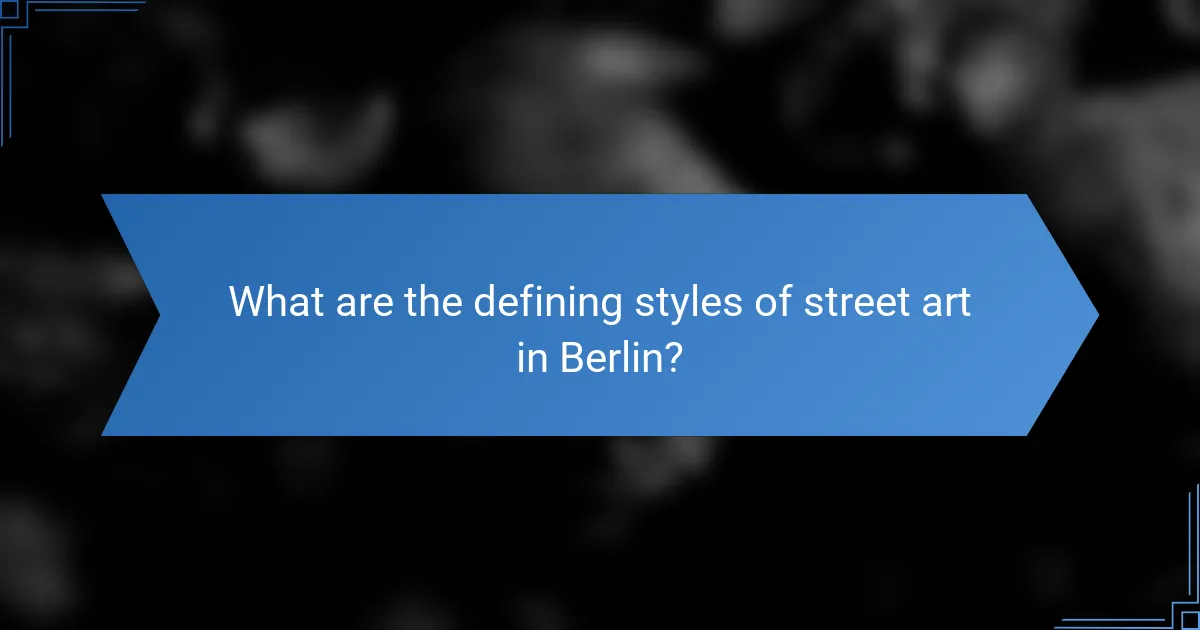
What are the defining styles of street art in Berlin?
Berlin’s street art features diverse styles, including graffiti, stencils, and murals. Graffiti often showcases vibrant colours and bold lettering, while stencils deliver sharp imagery with social commentary. Murals, on the other hand, emphasise large-scale artistic expressions, often reflecting cultural themes. Unique attributes include the city’s legal walls, which encourage artistic expression, and the annual Berlin Mural Fest that showcases new talent. Rare styles like paste-ups and yarn bombing also contribute to the city’s dynamic street art scene.
How do different cultural influences shape Berlin’s street art?
Cultural influences significantly shape Berlin’s street art, reflecting the city’s diverse history and communities. Various styles emerge from immigrant cultures, local artists, and political movements, creating a rich tapestry of expression. For example, Turkish and Arabic influences introduce unique motifs and messages, while the legacy of East German graffiti adds historical context. The interaction of these elements fosters a vibrant art scene that evolves continuously, making Berlin a dynamic hub for street art enthusiasts and photographers.
What role do local artists play in defining these styles?
Local artists significantly shape street art styles in Berlin through their unique cultural expressions and community engagement. They introduce innovative techniques and themes, reflecting local identity and social issues. Their contributions foster a vibrant art scene, attracting tourists and inspiring new artists. Collaborations among artists often lead to distinctive murals that enhance the urban landscape. This dynamic interplay between artists and the city defines Berlin’s street art as a living, evolving entity.
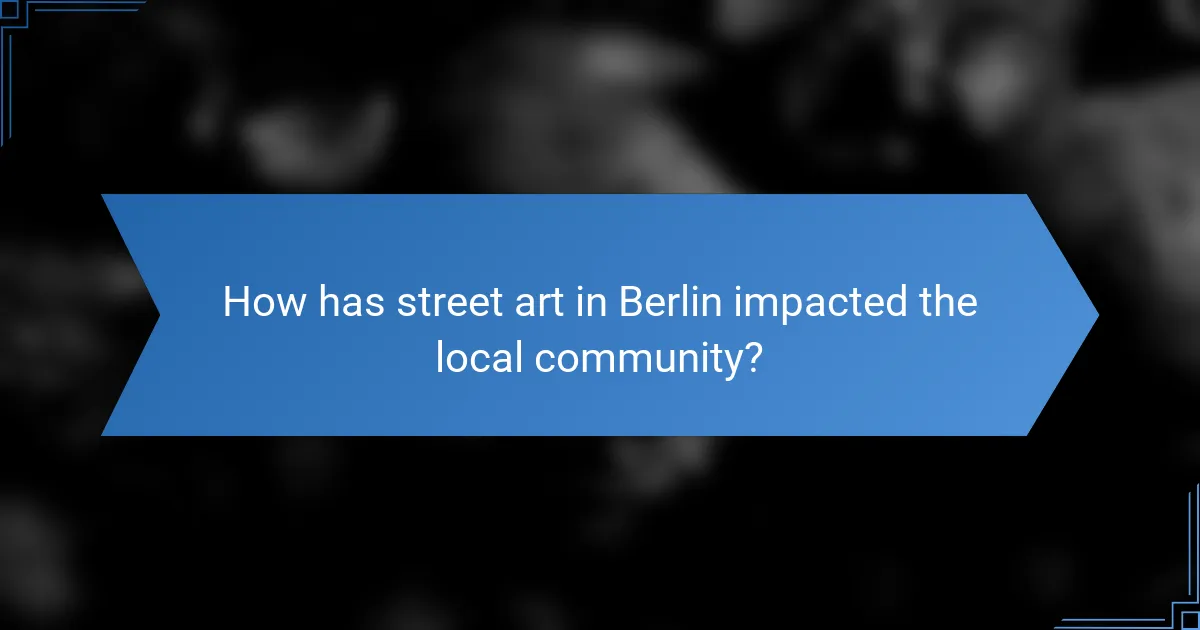
How has street art in Berlin impacted the local community?
Street art in Berlin has significantly enriched the local community by fostering cultural expression and social dialogue. It serves as a canvas for artists, reflecting diverse voices and addressing social issues. This vibrant art form attracts tourists, boosting local businesses and promoting community pride. Furthermore, initiatives supporting street art have transformed neglected spaces into lively public areas, enhancing urban aesthetics.
What are the social implications of street art in urban spaces?
Street art in urban spaces, particularly in Berlin, fosters community engagement and cultural expression. It challenges social norms and stimulates dialogue among diverse populations. Street art often reflects local issues, enhancing awareness and prompting conversations about identity, politics, and social justice. As a result, it can serve as a catalyst for urban regeneration, attracting tourism and revitalising neighbourhoods. Additionally, the unique styles found in Berlin’s street art scene, such as stencil art and murals, contribute to the city’s cultural identity and artistic landscape.
How does street art contribute to Berlin’s tourism and economy?
Street art significantly boosts Berlin’s tourism and economy by attracting visitors and enhancing local culture. The vibrant street art scene draws millions annually, contributing to a thriving creative economy. Unique murals and installations promote local artists and businesses, creating jobs and increasing foot traffic in neighbourhoods. As a result, Berlin’s reputation as a cultural hub continues to grow, fostering investment and community engagement.
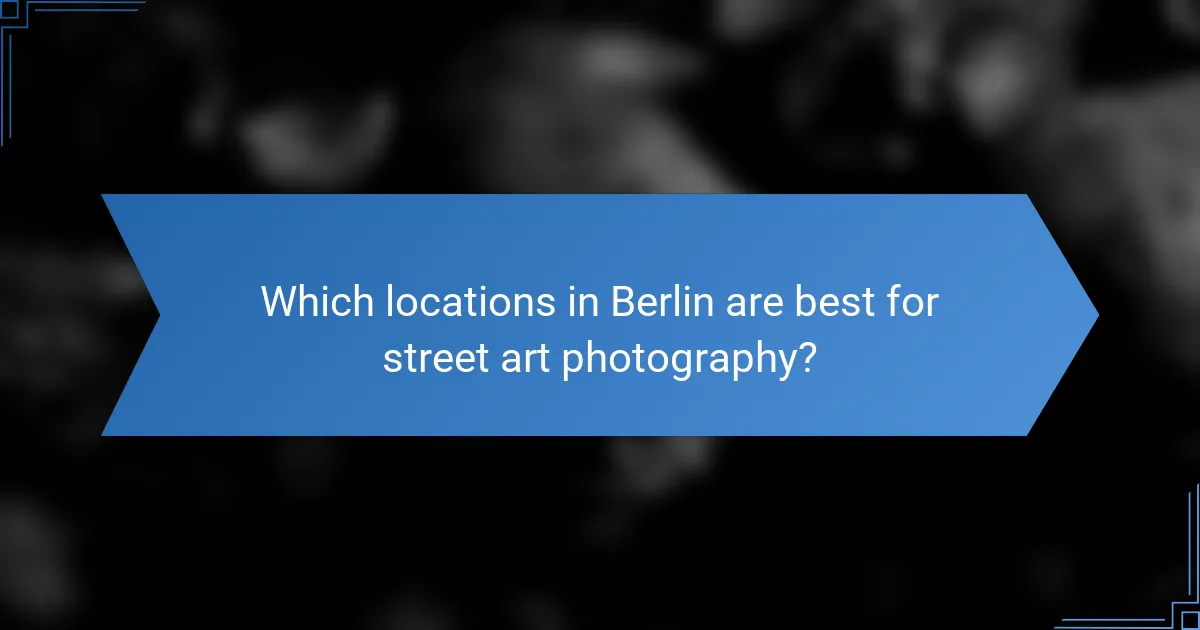
Which locations in Berlin are best for street art photography?
The best locations for street art photography in Berlin include Kreuzberg, Friedrichshain, and Mitte. These neighbourhoods feature vibrant murals and graffiti, showcasing diverse styles and cultural messages. Kreuzberg is known for its political art, while Friedrichshain offers large-scale murals. Mitte hosts a mix of contemporary and classic street art, making it a must-visit for photographers.
What are the top neighbourhoods known for vibrant street art?
Berlin is renowned for its vibrant street art, with neighbourhoods like Kreuzberg, Friedrichshain, and Mitte leading the scene. Kreuzberg showcases a mix of styles, including political murals and abstract pieces. Friedrichshain features the famous East Side Gallery, a long stretch of the Berlin Wall adorned with diverse artworks. Mitte offers a blend of contemporary and traditional street art, attracting photographers and art enthusiasts alike. Each area reflects the city’s rich cultural history and artistic expression.
How can photographers best capture the essence of street art?
Photographers can best capture the essence of street art by focusing on unique styles, vibrant colours, and the context of the artwork. Explore various locations in Berlin, such as Kreuzberg and Friedrichshain, where street art thrives. Utilise natural light to enhance textures and details. Engage with the local culture to understand the message behind the art, which adds depth to your photographs. Experiment with different angles to showcase the artwork’s scale and surroundings.
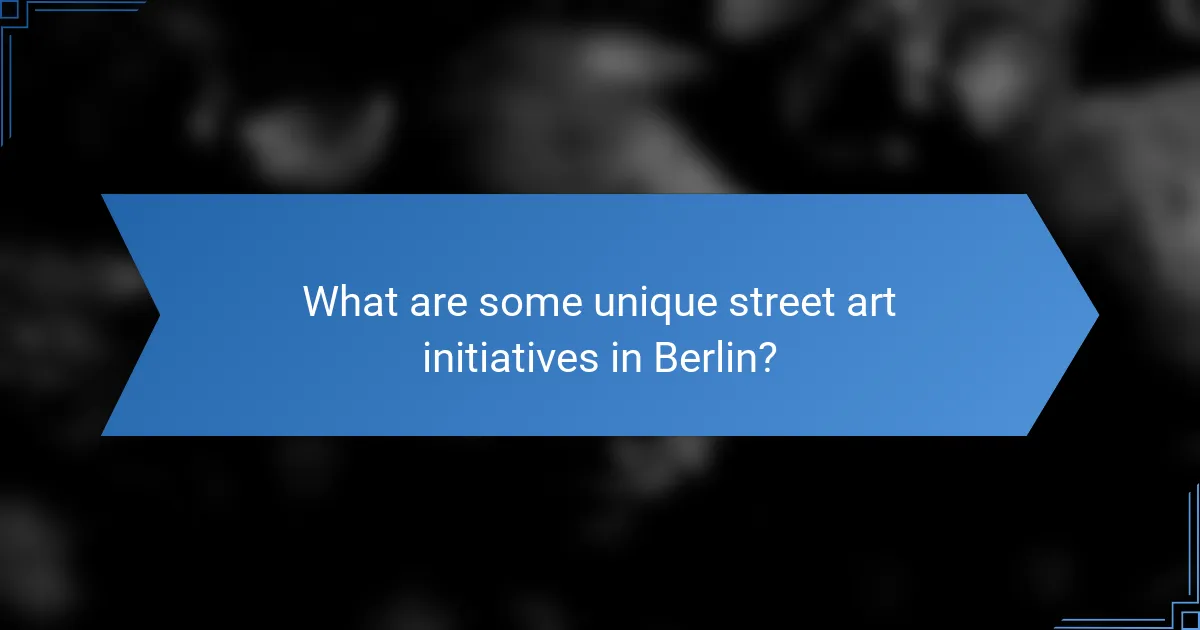
What are some unique street art initiatives in Berlin?
Berlin hosts several unique street art initiatives that enhance its vibrant urban landscape. One notable project is the East Side Gallery, a 1.3 km stretch of the Berlin Wall adorned with murals from international artists. Another initiative is the Urban Nation Museum for Urban Contemporary Art, which showcases street art and promotes artists through exhibitions and workshops. The Mural Fest transforms public spaces by commissioning large-scale murals from renowned street artists, making art accessible to all. Additionally, the Berlin Street Art Tours provide insights into the stories behind the artworks and their creators, fostering appreciation for this dynamic art form.
How do collaborations between artists and businesses enhance street art visibility?
Collaborations between artists and businesses significantly enhance street art visibility by providing resources, exposure, and legitimacy. Businesses often fund projects or offer wall space, which increases the artwork’s reach. For instance, murals sponsored by brands attract foot traffic and media attention, showcasing the artists’ work to broader audiences. Additionally, partnerships can lead to community events, further amplifying the art’s presence. This synergy not only benefits artists but also enriches the cultural landscape of cities like Berlin, making street art more accessible and appreciated.
Which events celebrate street art culture in Berlin?
Berlin celebrates street art culture through various events like the Berlin Street Art Festival, Urban Nation Museum exhibitions, and the annual Mural Festival. These events showcase local and international artists, highlighting diverse styles and the impact of street art on urban landscapes. The festivals often include live painting, workshops, and guided tours, providing opportunities for photography and engagement with the art community.
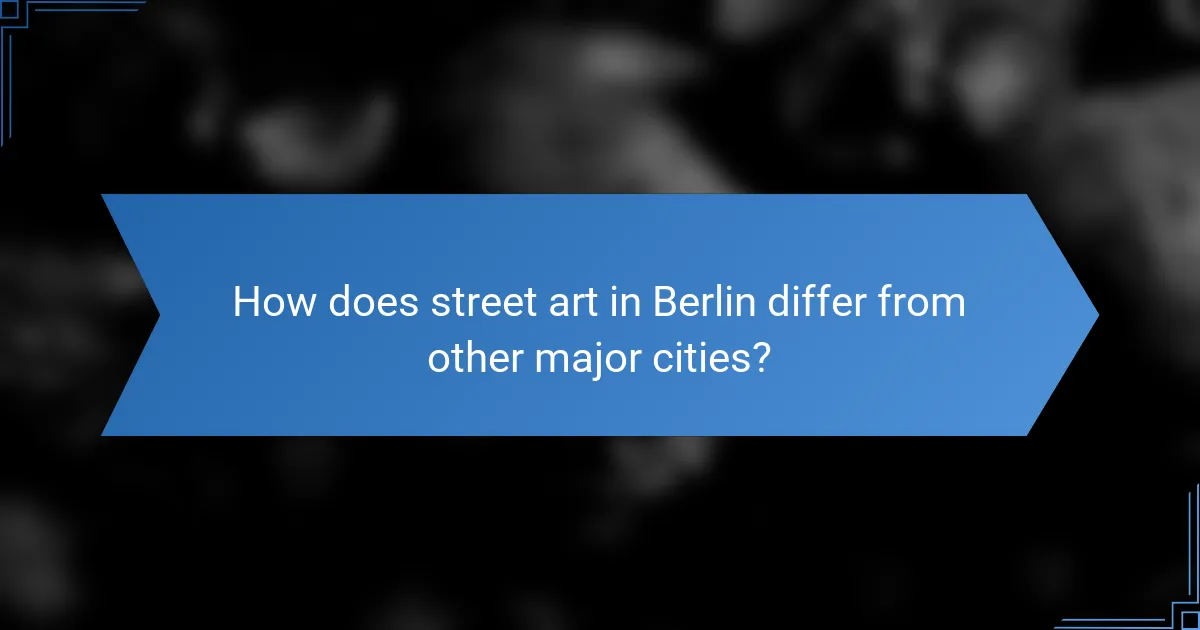
How does street art in Berlin differ from other major cities?
Street art in Berlin stands out due to its unique blend of styles, historical context, and cultural significance. Unlike other major cities, Berlin’s street art is deeply influenced by its turbulent history and vibrant subcultures. The city showcases a diverse range of styles, from politically charged murals to intricate stencils and paste-ups.
Berlin’s graffiti scene is known for its bold statements and social commentary, often reflecting the city’s identity and history. In contrast, cities like Paris or New York may focus more on aesthetic appeal or commercial art.
Key locations for photography include the East Side Gallery, a preserved section of the Berlin Wall adorned with murals, and districts like Kreuzberg and Friedrichshain, known for their dynamic street art. These spots offer a rich visual narrative, making Berlin a top destination for street art enthusiasts.
What are the unique challenges faced by street artists in Berlin?
Street artists in Berlin face unique challenges such as legal restrictions, gentrification, and public perception. Legal issues arise from the need for permits, which can limit creative expression. Gentrification often leads to the displacement of artists as neighbourhoods change. Additionally, public perception can vary, with some viewing street art as vandalism rather than legitimate art. These factors create a complex environment for artists striving to make their mark in the city.
How does the legal landscape affect street art practices?
The legal landscape significantly influences street art practices in Berlin. Laws regarding public space usage and copyright shape artists’ opportunities and limitations.
Street artists often navigate complex regulations that can either hinder or foster creativity. For example, the city’s tolerance for murals may encourage larger, more expressive works, while strict enforcement against unauthorised tagging can suppress spontaneous expressions.
Additionally, the presence of art festivals and city-sponsored projects creates platforms for legal street art, enhancing community engagement and visibility.
Overall, the interplay between law and creativity in Berlin’s street art scene reflects a dynamic tension that shapes artistic expression and public perception.
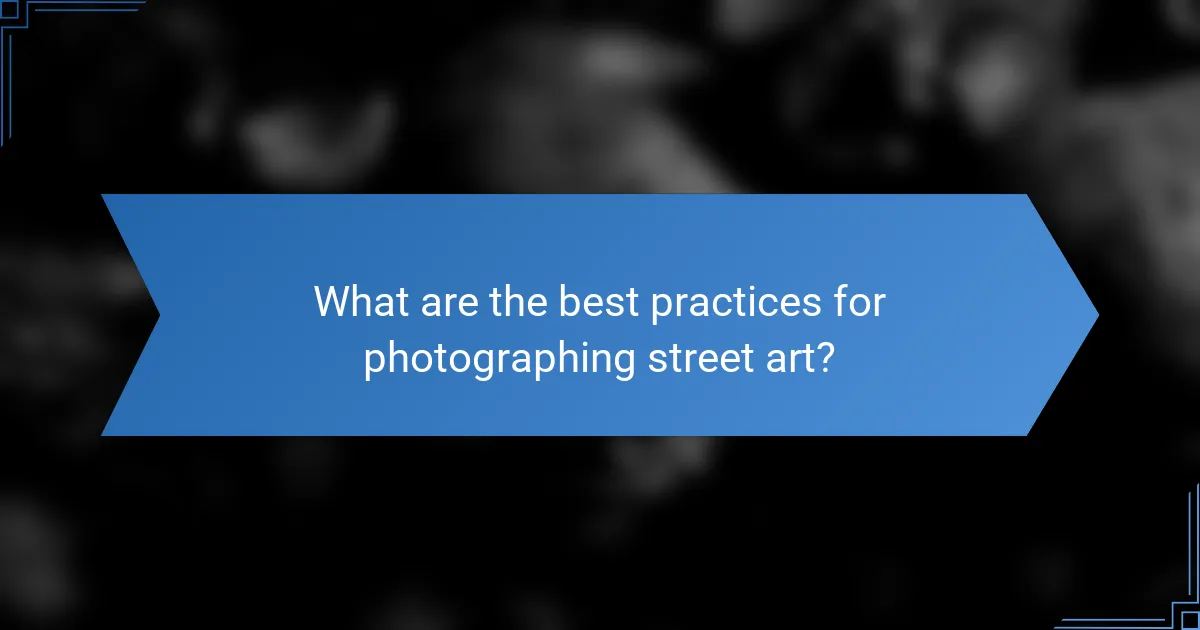
What are the best practices for photographing street art?
To effectively photograph street art, focus on lighting, composition, and angles. Use natural light to enhance colours and textures. Explore various perspectives to capture the art’s context. Consider including surrounding elements for storytelling. Be respectful of the artists and neighbourhoods.
What common mistakes should photographers avoid when capturing street art?
Photographers should avoid common mistakes like not considering lighting, ignoring composition, and failing to respect the art and artists. Understanding the unique attributes of street art in Berlin enhances photography.
1. Neglecting lighting conditions can result in poor image quality.
2. Overlooking composition leads to unbalanced photographs.
3. Disregarding the context of the artwork diminishes its impact.
4. Not asking for permission can offend artists and damage relationships.
5. Failing to capture the environment misses the essence of street art.
6. Rushing shots can lead to missed details and opportunities.
How can photographers enhance their street art portfolios effectively?
Photographers can enhance their street art portfolios by focusing on unique styles, impactful narratives, and ideal locations. Explore Berlin’s diverse street art scene to capture vibrant murals and thought-provoking pieces. Utilise the golden hour for optimal lighting and consider angles that highlight the art’s context. Engage with local artists to gain insights and access exclusive spots, enriching your portfolio with authentic content. Document the stories behind the art to provide depth and connection in your photography.